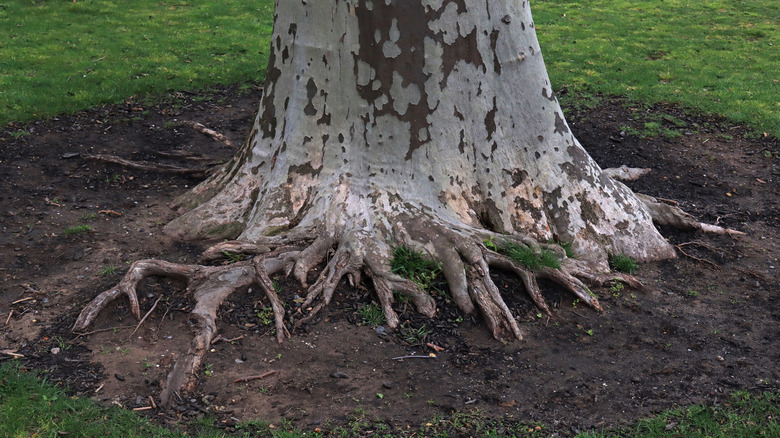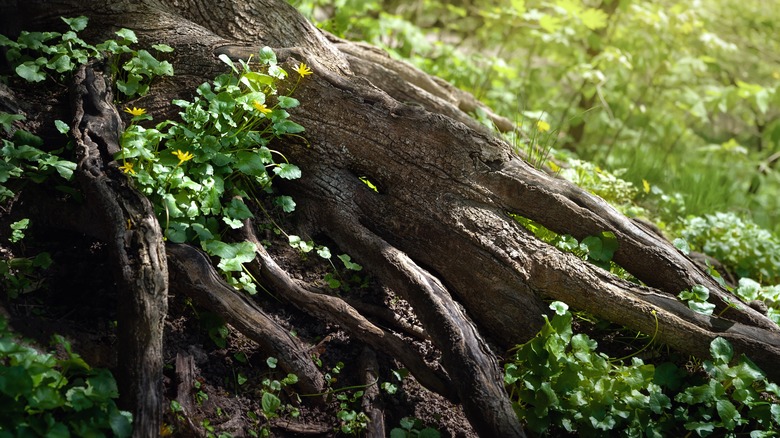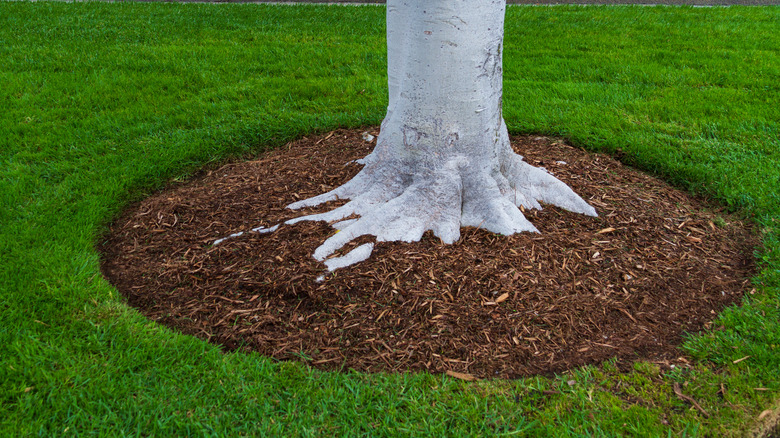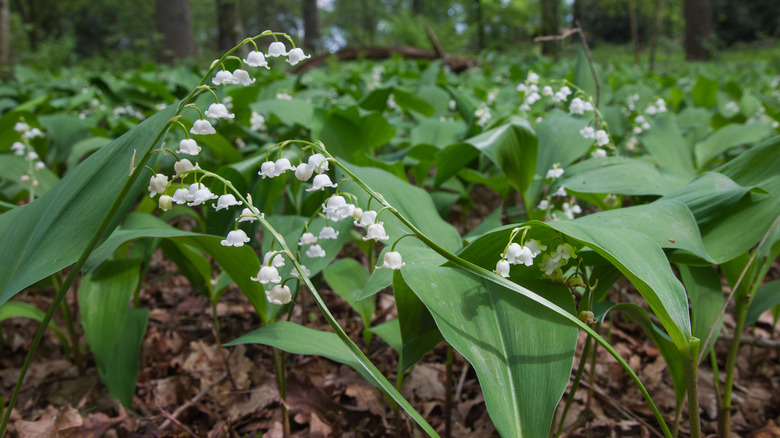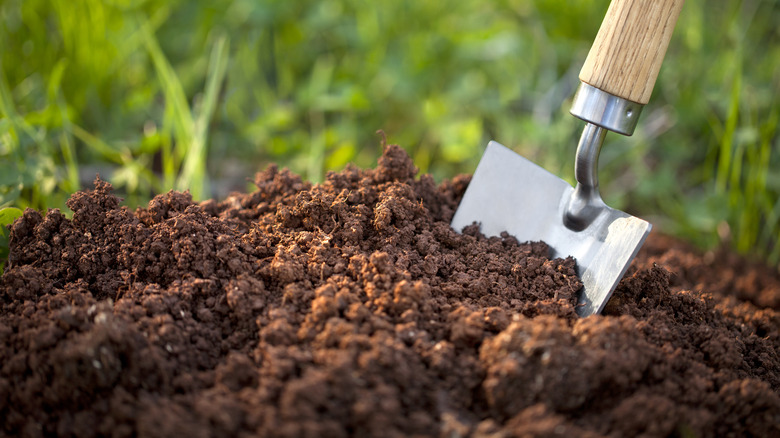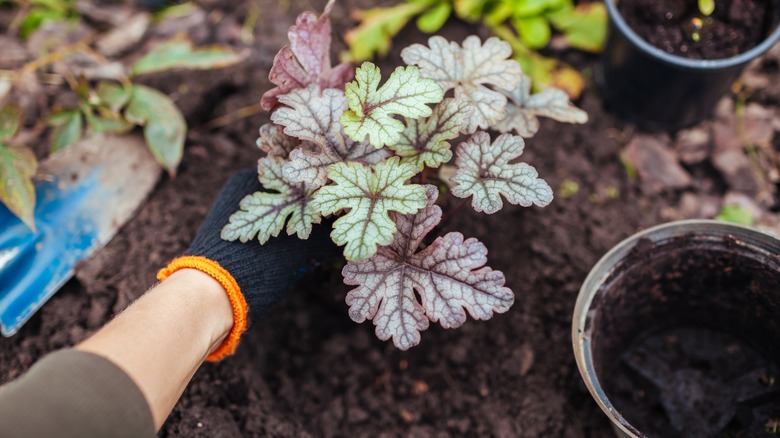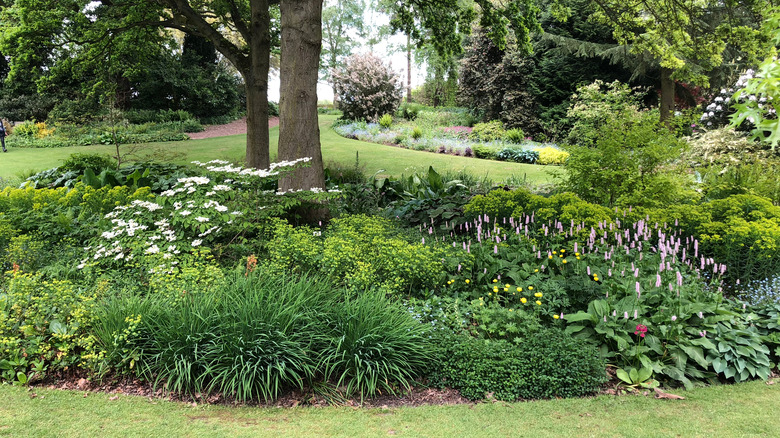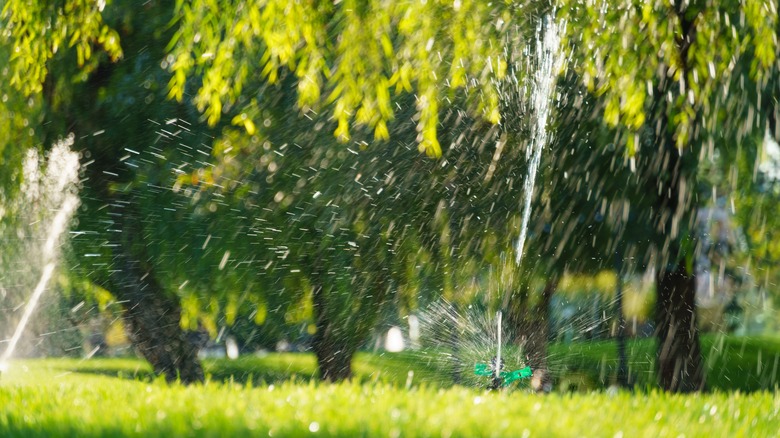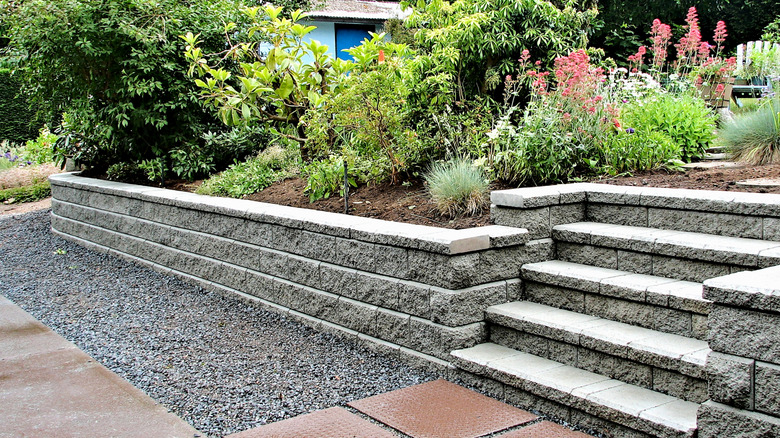Simple Gardening Tips For Landscaping Around Exposed Tree Roots
Trees are vitally important components of a healthy and beautiful landscape. They increase the curb appeal of your home, regulate its temperature, conserve the soil, improve the air quality, and provide a haven for wildlife. But the sight of a tree's roots spreading above ground can spoil the aesthetic quality of your landscape. Exposed roots not only look ugly, but they also present a trip-and-fall hazard for anyone walking near the tree.
Presented with this problem, you might wonder what you can do to improve the landscape around a tree with visible, above-ground roots. We've collected suggestions for remedies that respect the health of the tree and its roots as a top priority. Read on to explore the best practices for mulching and planting around exposed tree roots, including beneficial landscaping techniques and the harmful ones to avoid. Additionally, you'll find numerous suggestions for plant selection and gardening methods that will help you transform the sight of exposed tree roots into a pleasant part of your landscape.
Always protect the tree roots from damage
When landscaping around trees, your primary objective should be to avoid disturbing the roots in any way. They contribute to the tree's health by absorbing oxygen, water, and nutrients from the soil. While some trees send their roots deep into the ground, others are shallow-rooted and spread along the top of the soil. These include birch, ash, pear, and willow. In addition to natural growth patterns, tree roots may become exposed above ground due to environmental factors. If the soil is compacted and erosion occurs or if the tree doesn't have enough space to grow properly, its outward-spreading roots will emerge above the soil.
The roots of any tree hold it firmly to the ground and keep it alive, so it's crucially important to leave them intact. For this reason, you should never use deeply invasive landscaping tools and techniques around tree roots. Leave the shovel, spade, pickaxe, and rototiller in the shed when you're working around exposed tree roots. Never prune, cut, or chop the tree roots. These actions might destabilize the tree, increasing its risk of toppling over in a storm. Alternatively, the damaged roots could cease to nourish the tree, causing it to die. Before adding these root-protective methods to your gardening routine, assess the health of the tree first to verify its state. Do so by learning how to use a penny to check the health of your trees.
Add mulch, but do not add soil to raise the grade
You're staring at an expanse of bare dirt and straggly bits of grass with gnarly, above-ground roots sprawling in all directions beneath a tree in your landscape. To improve the eyesore, your first question might be: Should you cover a tree's exposed roots with soil? Though it's an appealing idea to deposit a deep load of topsoil to create a planting bed for a lovely shade garden under the tree, don't do it. This landscaping strategy will likely result in the death of your tree. The roots need to breathe, and covering them with deep soil prevents them from absorbing vital oxygen that keeps the tree alive.
It's okay to add just enough good-quality garden topsoil to cover the exposed roots by a scant half-inch. But don't use soil to raise the landscape grade around the tree. The best treatment for exposed tree roots is to cover them with 2 to 3 inches of organic mulch. A circle of mulch that extends outward from the tree trunk to the canopy drip line creates a clean and natural look in your landscape. Avoid mounding the mulch up against the tree trunk. For young trees, place the mulch 3 to 5 inches away from the trunk.
In the case of mature trees, start the mulch circle 8 to 10 inches out from the tree's trunk. While it covers the roots and holds moisture in the ground, the mulch is not so dense that it cuts off oxygen from the tree roots. For these reasons, organic mulch contributes to the tree's health while it improves the aesthetic appearance of the landscape under the tree.
Incorporate ground cover plants, but do not plant grass
With a thin layer of topsoil and 2 to 3 inches of mulch covering the exposed roots under a tree, you might want to add a bit of greenery. This will make the area blend in with your landscape. While turf grass might be the best answer for covering an open, sunny expanse in your yard, it's not a viable option for a location where tree roots appear above the ground. Grass maintenance requires mowing, and using a lawn mower around exposed tree roots can damage them as well as the mower blades. On top of that, grass and trees do not respond well to the same water, sunlight, and nutrient conditions, and the tree will outcompete the grass for life-giving necessities under its canopy.
Fortunately, grass is not your only recourse for incorporating greenery around the tree roots. The many ground cover plants you should grow instead of grass in your yard will do the job. These include vinca minor, pachysandra, lily of the valley, lungwort, creeping jenny, ferns, liriope, purple heart, ajuga, and sweet woodruff. Start by carefully removing any bits of grass and weeds without disturbing the roots. Then, transplant the ground-cover seedlings amid exposed tree roots by digging the smallest holes possible while avoiding contact with the roots. If you start to dig a hole and run into a root, refill it and move on to a new location. Water the newly planted ground cover and distribute organic mulch evenly around the area.
Dig small holes with these tools to avoid nicking the tree roots
When you're heading out to plant shrubbery and perennials in your garden's planting beds, you might grab a spade or your favorite round-point shovel. But when you're planting under a tree, it's best to leave those tools behind. Instead of digging large holes, you might think of inserting the new plants amid the tree roots with surgical precision. You'll want to minimize the disturbance of the soil and the roots as much as possible. When plants are tucked between the exposed tree roots, their small, spreading roots help to aerate the soil, allowing the large tree roots to absorb more oxygen.
Employ small hand tools to plant ground covers and other shallow-rooted plants amid exposed tree roots. Start by using the CLZOUD Garden Trowel Tool from Walmart to remove existing grass and weeds without banging into the tree's roots. Next, you'll want to use the Fiskars Ergo Hand Tool Kit from Lowe's. It includes a handheld trowel as well as a pointed-nose transplanter for digging small holes under a tree. Additionally, the included cultivator allows you to loosen the soil without disturbing the tree roots. As an option, you might want to use the Husky Stainless Steel Bulb Planter from The Home Depot to dig precision planting holes in between the tree roots. Working carefully with the small hand tools, you'll preserve the health of your tree and its roots while you fill the area with lovely greenery and flowers.
Plant small perennials or annuals that have shallow roots
You may have noticed that lush vegetation simply does not grow in the soil between exposed tree roots. But it is possible to grow plants whose roots do not extend deep into the soil. A shallow layer of planting medium combined with a few inches of mulch will support ground covers and bulb plants, as well as some perennials and flowering annuals.
Before inserting your new plants, it's safe to add 2 to 4 inches of soil around the tree roots. This amount of topping will not smother the roots and deprive the tree of oxygen, but it does offer a place for shallow-rooted plants to take hold. When you're working around exposed tree roots, it's important to dig small, shallow holes that are only as deep and wide as necessary to insert the new plants. Small bulbs like snowdrops, cyclamen, and crocuses require only a couple of inches of soil, making them ideal for tucking around tree roots. Perennial plants like coral bells (Heuchera), hellebore, and woodland phlox require only a shallow layer of soil for their root systems. Among the annual varieties, consider pansies, vincas, impatiens, and coleus as viable candidates that thrive in shallow soil.
Select shade-tolerant plants to grow under the tree
When you're trying to improve the look of your landscape around exposed tree roots, it's a given fact that any plants you introduce to the area will need to thrive in the shade. For this reason, you can immediately eliminate candidates that require full sun or partial sun. If the tree offers deep shade, you'll know to search for small plants in the full-shade area of your favorite nursery. On the other hand, a tree with sparse branches might provide dappled shade as sunlight filters through the leaves, creating a friendly environment for plants that are designated to grow in partial shade. To help you get started, see our guide on the beautiful flowers that grow perfectly in shade.
Perennials that thrive in the full shade of a dense tree canopy include ferns, hostas, and bleeding hearts. For the area under a tree that provides partial shade, try planting barrenwort, coral bells, columbine, or Baltic parsley for their perennial beauty that returns every year. If you enjoy annuals for the flexibility of changing your display each year, you might insert polka dot plants, begonias, impatiens, or caladium in between the exposed roots of a tree that offers full shade. On the other hand, a partially shaded terrain with above-ground tree roots might be a good home for nasturtiums, coleus, lobelia, nemesia, and sweet alyssum.
Provide adequate water and nutrients for the tree and plants growing under it
When you insert new plants to improve the landscape around exposed tree roots, you're introducing the plants to a tough, competitive environment. Through its roots, the tree takes up the water and nutrients in the soil. As you introduce the new plants to the space under a tree with exposed roots, you're asking them to flourish and grow in shallow soil and full or partial shade with stiff competition for the available water and nutrients.
As a strategy for success, it's crucial to provide plenty of extra water and fertilizer during the first two to three years while the young plants strive to become established. In fact, you can expect to give twice as much water and plant food to plants in the exposed-root area compared to other plants in your garden. Additionally, you'll want to select plants that can adapt to the lack of sunlight and water. Shade-loving perennials that tolerate dry conditions include barrenwort, black cohosh, Japanese painted fern, lungwort, columbine, Pennsylvania sedge, lily of the valley, aster, Christmas fern, and more.
Build a retaining wall to prevent further erosion under the tree
In some locations, a tree's roots might become exposed due to erosion of the soil that originally surrounded them. This is especially true of trees that grow on hillsides or sloping terrain where rainwater runs off at a rapid pace. Due to gravity, the run-off carries topsoil with it to lower elevations, leaving the roots exposed above the remaining soil. Building a retaining wall (the do's and don'ts) with pavers or stone might be a viable solution to the problem. It can be a DIY project for an energetic gardener.
When planning the installation of a retaining wall, be sure to measure a sufficient distance from the tree that will allow you to dig without disturbing the tree's roots. For example, if the tree is 20 feet tall, you'll need to place the retaining wall 20 feet away from the tree trunk. First, dig a level trench and fill it with 6 inches of packed gravel. Next, lay the first course of blocks or stones and fill the extra space in the trench with loose gravel. Then, lay the desired rows of block or stone, securing them with concrete. After the wall is complete, you can backfill with soil. As you backfill, use caution to avoid smothering the exposed tree roots. Cover them with no more than 2 to 4 inches of soil, as a deeper deposit of topsoil could kill the tree.
